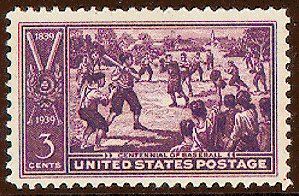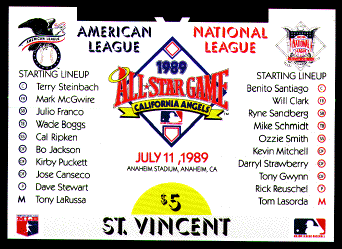
| Congratulations from Skilton's Baseball Links! Your "Baseball on Postage Stamps" site has been selected as the "Baseball Link of the Week" for September 22 - 28. Thanks for maintaining an outstanding baseball site! [other awards] |

| Congratulations from Skilton's Baseball Links! Your "Baseball on Postage Stamps" site has been selected as the "Baseball Link of the Week" for September 22 - 28. Thanks for maintaining an outstanding baseball site! [other awards] |
|
E d S t e p h a n
When FDR's Postmaster General James A. Farley proposed a stamp honoring baseball, to coincide with the opening of the Hall of Fame in 1939, a nationwide poll of collectors voted overwhelmingly against it. They were over-ruled by stamp-collecting President Roosevelt who said through the nation's sports pages that he wished "every boy in America could get a first-day cover [stamped envelope mailed the day of issue]."
 The post office at Cooperstown was swamped with what were called "small boy orders," those arriving without the required self-addressed envelope plus three cents for the stamp. Local postmaster Melvin Bundy honored thousands of those requests out of his own pocket, and US baseball stamp collecting was born. Now one of the hottest "topicals" in all philately, baseball stamp collecting got surprisingly little push from its home nation. Thirty years passed before the centennial of professional ball was recognized. Only four players have been honored as such: Robinson, Ruth, Clemente and Gehrig -- all in the 1980s. A U.S. stamp for Olympic baseball showed up in 1992, and another appeared last year celebrating softball. Not much to work with compared with the thousands of baseball cards produced annually.
One problem facing the postal service is that stamps cannot be issued until an individual has been dead for at least ten years (one year for U.S. presidents is the only exception). So if you want a stamp honoring Ted Williams or Bob Feller or Gaylord Perry or Jr. Griffey, you have to look elsewhere. Nations with no baseball tradition of their own have found a goldmine selling stamps to U.S. collectors. You can get Don Mattingly from the Central African Republic, Roger Clemens or Kevin Mitchell from Comoro Islands, and Robin Yount from Guinea.
The baseball stamp craze embraces stamps printed on copper, silver and gold foil, akin to the metallic pressings seen in premium baseball cards of recent years. In 1992 St. Vincent and Grenadines issued the first ever baseball-stamp and baseball-card combination. There are twelve cards honoring "Baseball Hall of Fame Heroes": Cobb, Dean, Feller, Ford, Gehrig, Hornsby, Ott, Paige, Ruth, Stengel, Wagner and Young. Each is a legal $4 stamp (East Caribbean currency), should you wish to mail something from there. Each is also a baseball card, with a rear side showing career information, birth and death dates, and the date of Hall induction. In 1986 Grenada issued a set of eight stamps showing Donald Duck and his nephews, Mickey, Minnie and Goofy playing ball. The same year "souvenir sheets" embedded $5 stamps in larger pictures of entire ballparks full of Disney characters. In 1988 Grenada released nine "sheetlets" of nine stamps each, featuring such players as Molitor, Mantle, Ripken, Carew, Puckett and Carter. When the set was re-issued two years later, the stamp which had honored Pete Rose was replaced by one with no more than the words "U.S. Baseball Series I."
 Even the All-Star Game found itself on oversized, overpriced stamps produced solely for the U.S. market. Boston's Wade Boggs and Oakland's Eric Davis were featured in a Grenada 1987 All-Star issue. St. Vincent put out a $5 playing-card-size "stamp" with little more on it than the starting lineups for the 1989 All-Star Game.
 Traditional stamp collectors tend to be very critical of these efforts to cash in on the hunger for collectible baseball stamps. Such philatelic "productions" were never intended to be used for delivery of postage. It's a sentiment shared by those who look back fondly on the days when baseball cards were enclosed with something else (usually tobacco products or bubble gum) and collected for their esthetic rather than anticipated market value. Speaking of which, those who collect art can also collect baseball: a stamp honoring Grandma Moses shows a baseball game at its center, there's Walt Disney's Donald Duck at bat, and Norman Rockwell's painting of Three Umpires is on a stamp.
The list of baseball stamps, genuine postage or not, is impressive. There are well over 400 of them, with more coming out every year. The very first was issued by the Philippines, in 1934, to commemorate the Tenth Far Eastern Championship Games, a sort of regional olympics. There were three stamps in the set: baseball, tennis and basketball. Old as it is, the baseball issue can still be obtained from reputable dealers for well under a dollar, a nice present for the new collector. And there are variations that are always of interest to collectors. One shows an unintended ink splotch above the "T" in the word "EASTERN" at the stamp's base. Another is printed in darker brown ink rather than the yellow brown of the main issue. With a little effort and money you might still find an unbroken sheet of these first Philippine baseballs: seven rows of five stamps with an external border intact.
 A perfectly respectable collecting interest, in the opinion of most, is the First Day Cover (FDC), often made still more desirable with addition of a "cachet," printed or handmade artwork occupying some or all of the left-hand side of the envelope. They can be found through stamp publications, stamp shops, and local stamp shows. Probably the most popular FDC of all is that U.S. 1939 Centennial of Baseball, often referred to simply as #855 (from the numbering system developed for the Scott Standard Postage Stamp Catalogue, available through dealers and in most libraries). Unadorned 855 FDCs go for upwards of $30. Those featuring fancy decorative printing, perhaps also including hand-attached small photos of Cooperstown or baseball's mythical founder Abner Doubleday, fetch upwards of $200.
 This image is from Linn's Online.
The heavily autographed FDC sold at Southeby's, As baseball becomes more and more an international pastime, the hobby of baseball stamp collecting has also taken on a more international flavor, beyond obvious appeals to the insatiable US market. Japan has produced a number of attractive baseball stamps featuring National Athletic Meets, a "se-tenant" (joined) pair representing the 50th All-Japan High School Championship, and a three-stamp set in 1984 celebrating 50 years of professional baseball in Japan.
In 1988 Canada issued a stamp which challenges the United States claim to have originated the game. It celebrates the 150th year of Canadian ball (putting it a year ahead of our legendary 1839 US date). The claim is based on a letter to Philadelphia's Sporting Life describing a game played in Beachville, Ontario, 4 June 1838. Latin America is a major producer of baseball stamps as well as players. Collectors can find dozens of them from the Dominican Republic, Nicaragua and Venezuela. One of the most difficult stamps to obtain is a Colombia 1935. The stamp itself is relatively inexpensive, a few dollars, but the multi-sport set from which it is seldom separated can cost as much as $2000. Mexico, Costa Rica, Cuba, El Salvador, Guatemala, Honduras and Panama all have a long history of producing highly collectible baseball stamps.

The future of baseball stamp collecting looks as bright as the sport itself. Countries seemingly far removed from our national pastime, such as India and Pakistan, the Netherlands Antilles and Italy, Korea and San Marino, have produced beautiful stamps honoring the game (and before the current craze made such stamps so lucrative). The Republic of China honored its many international Little League championships with stamps. The inclusion of baseball in recent Olympic Games has stimulated further international issues--Laos, Madagascar, Spain, Maldives, British Virgin Islands, Liberia. Television has made baseball a virtual reality worldwide. With 21st century transportation it is bound to become an actual reality as well. Unlike baseball cards, stamps are generally inexpensive and easy to transport and store. There is bound to be still more rapid growth in the dynamic world of baseball stamp collecting. | ||||||||||||||||
| Homepage | Baseball | Stamps |
|---|